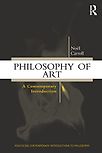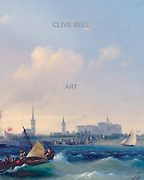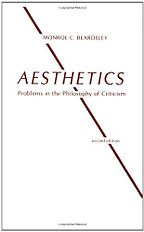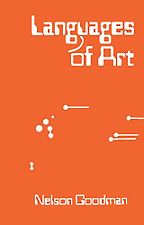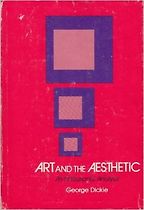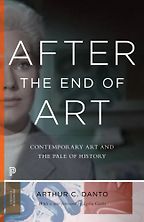Noël, how did you get involved in the philosophy of art?
There are two ways that people get involved in the philosophy of art. Some people are philosophers first – people with expertise in some specific field like metaphysics or epistemology or ethics or political theory. Let’s say those people get into philosophy of art by moving from some other form of philosophy which art raises some question about, and then they focus on the philosophy of art; I, on the other hand, found my way into the philosophy of art through art. I backed into it, whereas the people I’ve just mentioned walk into it. I was an active critic, especially of film, dance, and theatre. My practice raised various questions that I have felt I needed more comprehensive — more theoretical — answers to.
Could you give an example of the kind of question that stimulated you to get into philosophy? Often practising artists and even critics are sceptical about the subject, saying that it misses the point of the arts.
Well, as both an artist — I was a fledgling poet, and I did go to film school — and then as a critic at that time of my life, which was the 1970s, I was vexed by the tendency towards relativism. When I made various things, I didn’t mean them to be open to any interpretation possible. I also felt that a number of critics were using works of art to ride their own hobbyhorses, and defending this on the grounds of relativism. I wanted to investigate the philosophical foundations of that kind of interpretive freedom, and to discover whether or not there might be a philosophical foundation to my own conviction that some interpretations were right and others were wrong.
Now, the Five Books that you’ve chosen are all from the twentieth century, which has probably been history’s greatest century in aesthetics. Do you agree?
My view is that the philosophy of art is something that arose to deal with a specifically modern problem. Before the eighteenth century, people talked about the individual arts but they didn’t think of them as a unified system. In the eighteenth century you begin to get a feeling that certain things go together — poetry, theatre, dance, music, painting, and sculpture. Prior to that, things could be put together a little differently — music could go with mathematics, or painting could go with medicine, because both apothecaries and painters ground things in pestles. In the eighteenth century we get this formation of what we call the “Fine Arts” and what they called in those days the “Beaux Arts.” They were thought to be unified by the notion of the imitation of the beautiful in nature. But no sooner was that view afoot than there was a crisis: the crisis of absolute music. Absolute music — music without text or programmes — became more and more central. Other art was said to aspire to its condition but, of course, an imitation theory didn’t fit that view very well so other views had to be discovered and a whole range began to be fielded including expression theories, formal theories, and aesthetic theories. This, in turn, was exacerbated by the growing velocity of the appearance of an avant-garde. No sooner did one view of the nature of art appear than it had to be repaired because something else came down the pike.
“The task of saying what art is has got to be turned over to the philosophers.”
The reason I think that the philosophy of art is particularly modern, and the reason that the twentieth century was so involved with it, was that it had to deal with the constant challenge of the avant-garde. We see that in the first of the texts that I’ve chosen, by Clive Bell. His book, Art, is a defence of a then emerging avant-garde: the avant-garde movement of post-impressionism. Clive Bell is re-educating the English public in a treatise that’s also popular. He is re-educating their taste and how to look at this new work, that is not necessarily imitative. He is defending it with a theory that he claims is philosophical and applies to all art.
That theory is his theory of ‘Significant Form.’ This is the very influential idea that it doesn’t matter what a picture is a picture of, it doesn’t matter whether or not music imitates sounds in nature, what matters is the pattern of the thing: its aesthetic form.
That’s right. For example, if you look at Raphael’s School of Athens, which is an assembly of all the philosophers of the ancient world, you notice that they are very balanced. One group, over on the right, is balanced by another group on the left. It’s that complex pattern that Bell thought was the object of what we call aesthetic experience or aesthetic emotion — and he calls an experience of ‘Significant Form.’ Art is that which has Significant Form, which causes an aesthetic emotion. What’s particularly important about this way of approaching art is what it factors out. It factors out concern that we might have thought was central in historical artworks which were concerned with religious, spiritual, moral, and political events. In the West, before the eighteenth century, most patronage of the arts was from the church or the state or the nobility. After the eighteenth century, the market and patronage opened up to the bourgeoisie. They begin to use these objects as diverse ways of occupying their increasing leisure time. Bell suggests that all of that past art — all those Madonnas, all those crucifixions, all those kings, all those pictures of battles — were never really about battles and kings, politics, morality, religion or the spirit: they were about composition, they were about achieving formal clarity: apprehension of formal clarity, which they regarded as this special emotional state that arises in the breast of the informed viewer – what Kant would call a kind of disinterested pleasure.
It was also a reaction against verisimilitude as measure of the worth of a painting.
Yes. If we think about it, verisimilitude is the most natural strategy for broadcasting religious conviction and doctrine, as well as political affiliation. Now, he never denied that paintings could be representational, he just said that it was irrelevant to its status as a painting — painting qua painting, as someone might put it. The fine arts, the visual arts, had always been deeply imbricated as a means of transmitting political and social and religious conviction. What he did, in a sense, was disenfranchise painting, separating it from the other realms of social practice in existence.
He also put a great emphasis on the individual’s eye. It was about looking and being moved by things rather than about knowing.
Yes, in that sense he was extremely anti-cognitivist. He called the state that the Significant Form was supposed to elicit ‘aesthetic emotion.’ If you wanted to know what aesthetic emotion was, he said it was a kind of ecstasy in which we were lifted out of the concerns of everyday life — concerns about taxes but also concerns like the First World War that happened right after he wrote his book.
Why did you recommend this book? What is it about Bell’s writing that appeals to you?
Compared to a great deal of philosophical writing, Art is very brisk and very well turned out. He has a good sense of a phrase. He also argues well. But the real reason that I chose this book is that it constitutes what we might call the ‘philosophical unconscious’ of aesthetics. Very few aestheticians would say that they are formalists in Bell’s sense, that is, that they think art is just a matter of Significant Form. And yet, there are a number of implications that flowed from formalism that many aestheticians take for granted. They would invoke them as their “intuitions.” For example, the idea that the author’s intention is irrelevant to the meaning of the work, that history and context are irrelevant to the meaning of the work, that issues of ethics, religion, and politics are out of bounds and not relevant to the aesthetic expression. All of those intuitions actually form a coherent cluster designed to take the work of art out of the normal flow of life, out of the way we normally interact with things. Partly because many aestheticians were taught in critical practices like the New Criticism, many of those things constitute a kind of aesthetic subconscious among philosophers. I think it’s important to see this in order to then appreciate the way the conversation about art and the nature of art develops later in the twentieth century.
The second book you’ve chosen is Monroe Beardsley’s Aesthetics. A very different book — much longer, much more complex, in many ways.
Monroe Beardsley was often joshed in a kindly way and called ‘the Dean of American Aesthetics’ by the next person we’ll talk about, Nelson Goodman. Beardsley was a lovely man. One way to understand his book, Aesthetics, is as a more rigorous version of the theory that Bell developed. It’s different, Beardsley would protest, because it’s not formalist. But like Bell, he believes that art is autonomous, separate from other kinds of concerns — cognitive concerns, moral concerns, political concerns and so on. When he began to write the book, it was in the shadow of Wittgenstein. In the first edition he didn’t even offer a definition of art because the Wittgensteinians were arguing that a definition in terms of necessary and sufficient conditions was impossible. When he re-issued the book in the 1980s with Hackett, he did offer a definition of art, and it is a definition that gives an incredible systematic unity to his theory. It is what he calls ‘the aesthetic theory of art’ whereby the function of art is to cause or bring about or afford or sustain a certain magnitude of aesthetic experience.
That aesthetic experience is understood as a combination of things mostly having to do with the non-cognitive feeling states — like a feeling of freedom, freedom from feelings of necessity, and a feeling of interpretive play. As in the case of Bell, what a work of art is conceived of is as something with a function — only that for Beardsley its function is not to cause aesthetic emotion, but to cause this other thing that is called aesthetic experience. This gave him a way of talking about quality in art: works that afforded more aesthetic experience were better than ones that afforded less. He also talks about the things that give rise to aesthetic experience in works of art: unity, variety, and intensity. So his theory told the critic what features to look for in works of art. What are reasons to say that a work of art is good? Well, if it has unity, if it has diversity, if it has intensity. You might wonder what falls under the category of intensity — it’s what he calls ‘regional qualities’ but everyone else calls expressive qualities. So, if you had a work that had an appreciable amount of unity, diversity, and intensity — so an appreciable amount of formal properties and expressive properties that would give rise to or afforded aesthetic experience — it would be a good work.
It’s almost as if he’s giving a quantitative analysis of quality.
Well, yes it is. Of course it’s hedged by notions like ‘a certain magnitude’ — it’s not as if he ever attempted to give numbers, nor did he tell you how you would sum a certain amount of unity with a certain amount of intensity, or how you would subtract a certain amount of intensity or a lack of intensity from a lack of unity. Nor did he ever help you discriminate — say — between features like the kind of unity that makes for aesthetic experience versus the kind that makes for monotony.
The third book you’ve chosen is by a quite different style of writer — Nelson Goodman — who for me fits the mould of an analytic philosopher much more than the previous two philosophers you’ve chosen.
I disagree. I think Bell is the father of analytic philosophy of art, to a certain extent. He’s the one that wants a definition: he says if we don’t have a definition of art, we gibber. In a way, his book is a response to Tolstoy, who also claimed we needed a definition of art. Tolstoy doesn’t think that we can really come up with the right kind of definition, unless we’re able to tell what makes art socially important. They break there. But Tolstoy is, in a way, a ghost that is haunting Bell. Bell sets down the claim that the job of a philosopher of art is to present a definition of the concept. As I said, there was a kind of Wittgensteinian interlude that said it couldn’t be done, and in the first edition of Aesthetics Beardsley is a little shy. But he hunkers down in the second edition and comes up with a definition in terms of necessary and sufficient conditions. Something is a work of art if, and only if, it has the primary intention of affording a certain magnitude of aesthetic experience. He is actually presenting a kind of empiricist/analytic philosophy of art. In that way, he’s making the philosophy of art respectable to analytic philosophers.
Get the weekly Five Books newsletter
I began by saying that some philosophers come to the philosophy of art from art and others come from other areas of philosophy. Goodman did have a deep personal relationship with art — he was an art-dealer for many years. But by the time he wrote about the philosophy of art, he was already a distinguished epistemologist — one of the most distinguished. He brought a great deal of prestige and cachet to the philosophy of art, but he was very different than Beardsley because, in the tradition of Bell, Beardsley made a distinction between aesthetic and cognitive experience. In that respect, Beardsley was a non-cognitivist. What you find in Goodman is the notion that aesthetic experience is cognitive through and through. Artworks, for him, are symbol systems. Art works tell you about the way the world is, they alert you to the presence of certain qualities and properties, and they show you the relationships between things, they reconfigure relationships between things. With Goodman, you find a real break with what I earlier called ‘the aesthetic subconscious.’ You find Goodman suggesting that art is a cognitive instrument which, among other things, means that it has a justifiable role in teaching us about the world because all artworks are, for him, certain kinds of symbols – either representations, exemplifications, or expressions.
It’s a very complex book, but sticking with the representations, one of the striking positions that Goodman takes is that realism in pictorial representation is just a matter of convention. What makes one picture more realistic than another is not to do with our perceptual apparatus or seeing the thing in the depiction of it, but is a matter of how we’ve been inculcated as children, within our culture.
Yes. One of his favourite sayings was that somebody complained that Picasso’s picture of Gertrude Stein did not look like her, and the response was, “It will.” By that he meant that our canons of realism are what we’re used to, and realism is really a matter of what we’ve been taught. You might think about that in relation to those medieval drawings of rhinoceroses, where they’re armour-plated as if they were knights on the field of Agincourt. The artists thought those pictures were realistic. We often don’t see the unreality of representations in our own times. To take a silly example, we didn’t think it was strange in Spartacus when we saw Kirk Douglas had a flattop. This was the hairstyle of our own day and hardly realistic. Goodman, in that sense, advocated an extreme form of relativism, and that set off a major debate in the discussion of representation that people like Danto attempted to rebut — with the pendulum swinging gradually to the view that picturing, at least in certain respects, is keyed to our perceptual system and that’s how we explain the fact that when we show pictures to people in other cultures, their recognition is either immediate or very fast.
Nelson Goodman does actually use an example of somebody showing photographs of familiar objects to people in a culture that didn’t have photography and them being unable to read the photograph.
Those anthropological stories and stories by missionaries have been questioned because it often turns out that people were not clear what they were being asked. Sometimes they thought they had been asked what the fabric or the surface was. When it was clarified what was being asked, they were able to identify, say, a picture of a chicken as of a chicken. There was also a question about the blurriness of some of the photographs. The cases may be a little more complicated with things like perspective. Perspective might be something that these claims can be made about, but object recognition is a different story. There was a very famous experiment here in New York. Two psychologists raised their child without any exposure to pictures: they tried to take them off the cereal boxes and everywhere else. I understand the child’s grandmother was very upset by this. Nevertheless, they then exposed the child to pictures when he was, I think, three years old. It turned out he was able to recognise both drawings and photographs at rates way, way, way above random, which gave some support to the hypothesis that at least some kind of object recognition capacities are hardwired. Also, some animals have been able to evince some response to pictures which also suggests that it’s not convention all the way down, although it is important to emphasise that there are conventions involved.
Let’s turn to the fourth book, which is George Dickie’s Art and the Aesthetic. Dickie is probably best known for his Institutional Theory of Art.
Yes. George Dickie, who I should tell you was my doctoral advisor, is very important as a transitional figure for several reasons. Notice, first of all, that his book is called Art and the Aesthetic — those are the two things that Beardsley wanted to link together in a functional relationship. It was the function of art to bring about aesthetic experiences. Dickie wanted to call into question the notion of aesthetic experience. He was very influenced by the feeling that philosophy of art needed to deal with developments in the avant-garde. Beardsley actually dimissed avant-garde counterexamples — from what we now call anti-aesthetic art — saying they were not art proper but comments on art, and he therefore excluded them from his definition. An example might be Duchamp’s “Readymades” — including a steel canine comb for combing dogs that he bought off a shelf in a department store. It really doesn’t seem to afford aesthetic experience and, in fact, Duchamp tried to pick things that would not be aesthetically pleasing. Though trained as a painter, he was against ‘retinal’ art. He thought art, like the art of the Middle Ages, should address the intellect, and not simply the senses. Dickie wanted to develop a concept of art which would encompass and cover all those features that avant-garde artworks presented which defy aestheticism of all sorts. For that reason, he argued that a functional account of art based on bringing about a certain emotion or state would be inadequate. If you wanted to know what made something a work of art, you had to look at contextual features. You had to look at various institutions of what he called, following Danto, the Artworld. In his initial theory, something was a work of art if it was presented in a certain institutional context, by the right kind of person, as ‘a candidate for appreciation.’
The model here is something like ordination in the Catholic Church. To become a priest, you have to meet certain qualifications: you have to be male, you have to be a certain age, and you have to have this status conferred on you by a bishop or an archbishop. Dickie was suggesting that, similarly, you have to have the status of art conferred by the right kind of person: a curator, a critic etc. People have often misunderstood this. The primary person who conferred this status was the artist and the work had to meet certain qualifications, it had to be intelligible as a candidate for appreciation. Many people resisted Dickie’s theory on the grounds that they thought it quite dubious that art should always include or require institutions and the way the current art world is organised. Surely people made art before there were institutions? Think of a lone Cro-Magnon man who walks down the riverside picking up various different coloured stones and puts them in his own configuration for his own delight. Surely, they would say, that is an artwork: a composition of sorts from which he took pleasure? Surely it didn’t require an institution for that? So, because of the strong suggestion that comes with the notion of an institution — like the Church or The Academy of Motion Picture Arts and Sciences — as an extremely formalised and hierarchical organisation, people resisted Dickie’s view.
Could you have had an institution of Cro-Magnon men?
Maybe there were various practices, decorative practices among people, that gave rise to organisations, though I think the people who make that argument think it’s quite clear there was no institution there. One could make a pleasing configuration for the purpose of just enjoying making something that is nice to look at. It’s not really clear how we could know the answer to that. A more logical version of the argument might be something like this: if we need the institution of art in order to have art, how do we explain the emergence of first art? The example that I gave of the Cro-Magnon someone might claim as an example of what first art looked like. How do you get first art on a view that what is required is institutions?
Another way in which Dickie was unfairly attacked was by people who thought that he meant conferral of high status when he talked about the conferral of status, because what’s unusual about Dickie’s approach in the history of aesthetics is that, for him, to call something a work of art isn’t particularly to commend it. It’s merely to give it neutral status.
That’s a very good point. Dickie draws a distinction between the notion of a classificatory view of art versus a more commendatory or honorific view of it. So when we say “Ah! That’s an artwork!” we mean that’s a good artwork. By the way, this is a problem which bedevils the discourse of the philosophy of art throughout its entire career. A formal theory like Bell’s, that art is Significant Form, has the consequence that there can’t be any bad art. But we’ve all been at nights at the theatre or the concert hall where we’ve experienced bad art. So that’s one problem with some of the functional theories — they have no room for bad art.
Surely they do because they can just say it’s art so-called?
Whereas I would say that the execrable play that I’ve been subjected to is certainly an artwork but a bad one. I would support this by saying ‘Look, it is an artwork because it has been set before me with a certain set of expectations that belong to a genre that is an art genre.’ It’s not something else. I wouldn’t be able to evaluate it if I couldn’t put it into the art category. So, I think there is a lot of pressure to accept a classificatory versus commendatory view of art. Though I have noticed that some people are reinserting the commendatory standard by the backdoor — people like Alan Goldman and Malcolm Budd who say, ‘the theories that I want to offer really only pertain to the good or the great art.’ So, they’ve acknowledged the classificatory versus commendatory distinction and then said, ‘but for philosophical reasons it’s not really relevant to what I’m doing.’
Let’s move on to your final choice: Arthur Danto’s After the End of Art. How would you characterise this book?
One of the primary achievements of Danto is that, as I mentioned earlier, there was a very strong Wittgensteinian interlude where people said art couldn’t be defined. The recurrent reason they gave was that if you had a theory in terms of necessary and sufficient conditions it would make the exploratory and expansionary dimension of art impossible because you would be setting down these parameters. One thing Dickie does, and Danto does in a different way, is to say you can have a theory in terms of necessary and sufficient conditions and it doesn’t involve any limits at all on what artists can do. In Dickie’s case, it’s evident through a number of his choices of avant-garde works. Danto makes the theoretical reason for that much clearer, because he points out that you can have objects that are indiscernible between being everyday things and being artworks. His most famous example is Andy Warhol’s Brillo box. At least in theory, this is indiscernible from the cartons that Brillo pads are delivered in to grocery stores.
We have to say “at least in theory” because Warhol’s Brillo boxes were made of plywood and the original ones were made of cardboard.
That’s right — so you could actually tell the difference. But we can change the example. If we go back to Duchamp’s canine grooming comb, it actually is indiscernible from all the other factory grooming combs that were made at the same time.
Danto is remembered for one big idea which is that indiscernible objects can have different properties — something which, on first hearing, sounds contradictory.
Danto is a big thinker. Like Goodman, he came to the philosophy of art with credentials from other areas. He has a metaphilosophy of philosophy which is that what identifies a problem as a philosophical problem is that it raises the problem of indiscernibles. What he has in mind is: from Hume we get the indiscernibility of constant conjunction versus causation, from Descartes, a perfect dream versus an experience reality, from Kant, counting out change as a matter of prudence versus a matter of morality. For Danto, you don’t really have a philosophical problem until you have a matter of indiscernibility. The reason for this is that he’s interested in the demarcation issue, how you tell philosophy from science. In Danto’s view science always has an empirical base, there’s always an observation that can make a difference between scientific theories. Philosophy is different because observations will not get you the difference between these things. What you need instead is, to use fancy vocabulary, a transcendental argument or, less fancily, an inference to the best explanation. What a philosopher does is explain the difference between indiscernibilia — in this case, artworks and real things.
“Somebody complained Picasso’s picture of Gertrude Stein didn’t look like her, the response was ‘It will’.”
What is the difference between artworks and real things? According to Danto, in After the End of Art it’s two things. A work of art is about something, it has a content. Secondly, it embodies, articulates, advances, or presents whatever it’s about in a manner which is appropriate to it. Suppose you want to make a triumphal arch. The content of a triumphal arch will be something like power. If you were to embody or articulate that in plaster of Paris, that would not be appropriate because it would be gone with the first rainstorm. The Arc de Triomphe in Paris is embodied in an appropriate form: stone which resists the elements. For every work of art, Danto will argue, it will be about something. Sometimes this is called having content, sometimes he calls it meaning. And then, this meaning will be articulated — he says embodied — in a form appropriate to its content. Here, by form, he means something like the human form, he doesn’t mean something schematic. Sometimes he calls his theory ‘the theory of embodied meaning’ which means that a work is about something and it’s embodied in an appropriate form. Andy Warhol’s Brillo box is about something: art as commodity, and it’s embodied in an appropriate form, namely a container for commodities.
Why is the book called After the End of Art?
The book is called After the End of Art because just as Warhol is rebelling against a certain modernist tradition, Danto, as a critical proponent of Warhol, is rebelling against the form of criticism linked to that tradition of modernism. The form of criticism that Danto is rebelling against is an evolutionary form of criticism where you see art as having a mission. After photography, representation and imitation are not what artists should be about because these can be achieved automatically by machines. What is art going to be about after photography and cinematography? One of the most powerful suggestions is that art will be about itself. Art will be about exploring its own nature, and will reconfigure the history of art. So we see, after Delacroix and Géricault, people like Manet who begin to alter proper perspective — in other words, acknowledge the constructed nature of the picture plane. Then, with the impressionists, we see the picture plane dissolving into dabs of colour. With cubists, the picture plane begins to be contracted in various ways. Pollock and the abstract expressionists dissolve the picture plane into lines and colour. And then, with someone like Morris Louis, you have an emphasis on the flatness of the painting: he literally puts his canvas in puddles of paint so that the canvas becomes saturated. What you begin to find is a story of painting by means of painting revealing and disclosing its essential nature as flat. In the manner in which paintings say something, they exemplify something about their essential nature. That leads to a kind of criticism where, either you can see how each contribution refines and sharpens that acknowledgement of the painting’s own nature, or it is retrograde. So, for example, surrealism is an outlier. It’s beyond the pale of history because it returns, in the work of Dali, say, to Renaissance deep space. You have a story that gives you a way of evaluating each artwork as either an accomplishment, if it falls into the narrative, or a lamentable throwback, if it doesn’t fall into it.
And Danto rejected that?
That’s what Danto rejected. He rejected it through his intensive study of Warhol because Warhol himself, and his generation, are involved in rejecting this idea. Crucial to this idea is that paintings are going to disclose the nature of painting by means of painting. But with Brillo boxes, if you can make something indiscernible from an everyday object, that thing that you’ve made as an artwork is not done by means of painting as such, since you’re not dealing with appearances. Therefore Danto surmises that the task of saying what art is has got to be turned over to the philosophers. That’s why it’s After the End of Art because the task of saying what art is, as modernism presumed the task, just hits a wall. You can’t disclose what art is by means of appearances if there are artworks that are indiscernible from real things.
Five Books aims to keep its book recommendations and interviews up to date. If you are the interviewee and would like to update your choice of books (or even just what you say about them) please email us at [email protected]
Five Books interviews are expensive to produce. If you've enjoyed this interview, please support us by donating a small amount.

